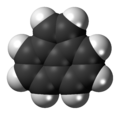Acenaphthylene
|
|
|||
| Names | |||
|---|---|---|---|
|
IUPAC name
Acenaphthylene
|
|||
|
Systematic IUPAC name
Tricyclo[6.3.1.04,12]dodeca-1(12),2,4,6,8,10-hexaene
|
|||
| Other names
Cycopenta[de]naphthalene, Acenaphthalene
|
|||
| Identifiers | |||
|
3D model (Jmol)
|
|||
| ChEBI | |||
| ChemSpider | |||
| ECHA InfoCard | 100.005.380 | ||
|
PubChem CID
|
|||
| UNII | |||
|
|||
|
|||
| Properties | |||
| C12H8 | |||
| Molar mass | 152.20 g·mol−1 | ||
| Appearance | Yellow crystals | ||
| Density | 0.8987 g cm−3 | ||
| Melting point | 91.8 °C (197.2 °F; 364.9 K) | ||
| Boiling point | 280 °C (536 °F; 553 K) | ||
| Insoluble | |||
| Solubility in ethanol | very soluble | ||
| Solubility in diethyl ether | very soluble | ||
| Solubility in benzene | very soluble | ||
| Solubility in chloroform | soluble | ||
| Hazards | |||
| R-phrases (outdated) | R22 R36 R37 R38 | ||
| S-phrases (outdated) | S26 S36 S37 S39 | ||
| Related compounds | |||
|
Related compounds
|
acenaphthene | ||
|
Except where otherwise noted, data are given for materials in their standard state (at 25 °C [77 °F], 100 kPa).
|
|||
|
|
|||
| Infobox references | |||
Acenaphthylene is a polycyclic aromatic hydrocarbon. The molecule resembles naphthalene with positions 1 and 8 connected by a C2H2 unit. It is a yellow solid. Unlike many polycyclic aromatic hydrocarbons, it has no fluorescence.
Acenaphthylene occurs as about 2% of coal tar. It is produced industrially by dehydrogenation of acenaphthene. More than 20% of the carbon in the universe may be associated with PAHs.
Hydrogenation gives the more saturated compound acenaphthene.
It functions as a ligand for some organometallic compounds.
...
Wikipedia


